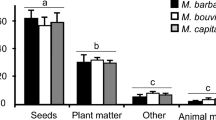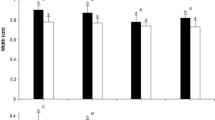Abstract
The harvester ant Pogonomyrmex mendozanus is endemic to the central Monte desert. In this region, extensive grazing reduces grass cover and seed abundance in the soil bank. In previous studies carried out in ungrazed areas, this ant species consumes and prefers seeds of perennial grasses over forbs and shrubs. However, in grazed habitats, P. mendozanus expands its diet by including seeds from other plant groups along with fruits, dead arthropods and other non-seed items. The broader diet could be due to a flexible foraging strategy or could reflect intrinsic, context-dependent food preferences of the populations inhabiting heavy grazed areas, different from those populations studied under ungrazed conditions. We carried out food preference experiments in heavy grazed areas in the central Monte desert in order to discriminate between both hypotheses. We performed choice experiments using a paired comparison design, offering seeds and non-seed food items present in the diet of P. mendozanus. Ants preferred large- and medium-sized perennial grass seeds and, among the non-seed food items, arthropods were preferred. Forb and shrub seeds along with fruits showed intermediate preference levels, whereas the least preferred items were small grass seeds and flowers. Food preferences were similar to those reported previously in ungrazed conditions, supporting the hypothesis that seed preferences are stereotyped in this species and strongly suggesting that it behaves as an expansive specialist by including less preferred items in its diet in heavy grazed habitats where the most preferred seeds are scarce.


Similar content being viewed by others
References
Anjos D, Dáttilo W, Del-Claro K (2018) Unmasking the architecture of ant-diaspore networks in the Brazilian Savanna. PLoS One 13(8):e0201117
Appleby MC (1983) The probability of linearity in hierarchies. Anim Behav 31:600–608
Bateson M, Healy SD, Hurly TA (2003) Context-dependent foraging decisions in rufous hummingbirds. Proc R Soc B 270:1271–1276
Belchior C, Del-Claro K, Oliveira PS (2012) Seasonal patterns in the foraging ecology of the harvester ant Pogonomyrmex naegelii (Formicidae, Myrmicinae) in a Neotropical savanna: daily rhythms, shifts in granivory and carnivory, and home range. Arthropod Plant Interact 6:571–582
Bertiller MB, Bisigato A (1998) Vegetation dynamics under grazing disturbance. The state-and-transition model for the Patagonian steppes. Ecol Austral 8:191–199
Boyd R, Silk JB (1983) A method for assigning cardinal dominance ranks. Anim Behav 31:45–58
Candolin U, Wong BBM (2012) Behavioural responses to a changing world: mechanisms and consequences. Oxford University Press, Oxford
Crist TO, MacMahon JA (1992) Harvester ant foraging and shrub-steppe seeds: interactions of seed resources and seed use. Ecology 73:1768–1779
Cueto VR, Marone L, Lopez de Casenave J (2006) Seed preferences in sparrow species of the Monte desert, Argentina: implications for seed-granivore interactions. Auk 123:358–367
de Vries HAN (1998) Finding a dominance order most consistent with a linear hierarchy: a new procedure and review. Anim Behav 55:827–843
de Vries HAN, Stevens JM, Vervaecke H (2006) Measuring and testing the steepness of dominance hierarchies. Anim Behav 71:585–592
Dingemanse NJ, Wolf M (2013) Between-individual differences in behavioural plasticity within populations: causes and consequences. Anim Behav 85:1031–1039
Dreber N, Esler KJ (2011) Spatio-temporal variation in soil seed banks under contrasting grazing regimes following low and high seasonal rainfall in arid Namibia. J Arid Environ 75:174–184
Dreber N, Oldeland J, Van Rooyer GM (2011) Species, functional groups and community structure in seed banks of the arid Nama Karoo: grazing impacts and implications for rangeland restoration. Agric Ecosyst Environ 141:399–409
Gammell MP, de Vries H, Jennings DJ, Carlin CM, Hayden TJ (2003) David’s score: a more appropriate dominance ranking method than Clutton-Brock et al.’s index. Anim Behav 66:601–605
González Loyarte MM, Rodeghiero A, Buk E, Trione Y (2000) Análisis comparativo de dos comunidades en el bosque de Prosopis flexuosa DC. del NE de Mendoza, Argentina Multequina 9:75–89
Groom MJ, Meffe GK, Carroll CR (2006) Principles of conservation biology, 3rd edn. Sinauer Associates, Sunderland
Heller R (1980) On optimal diet in a patchy environment. Theor Popul Biol 17:201–214
Hemelrijk CK, Wantia J, Gygax L (2005) The construction of dominance order: comparing performance of five methods using an individual-based model. Behaviour 142:1037–1058
Hooper-Bui LM, Appel AG, Rust MK (2002) Preference of food particle size among several urban ant species. J Econ Entom 95:1222–1228
Johnson DH (1980) The comparison of usage and availability measurements for evaluating resource preference. Ecology 61:65–71
Judd TM (2005) The effects of water, season, and colony composition on foraging preferences of Pheidole ceres (Hymenoptera: Formicidae). J Insect Behav 18:781–803
Kay A (2004) The relative availabilities of complementary resources affect the feeding preferences of ant colonies. Behav Ecol 15:63–70
Kelrick MI, MacMahon JA, Parmenter RR, Sisson DV (1986) Native seed preferences of shrub-steppe rodents, birds and ants: the relationships of seed attributes and seed use. Oecologia 68:327–337
Landau HG (1951) On dominance relations and the structure of animal societies: I. Effect of inherent characteristics. Bull Math Biophys 13:1–19
Luna P, García-Chávez JH, Dáttilo W (2018) Complex foraging ecology of the red harvester ant and its effect on the soil seed bank. Acta Oecol 86:57–65
Marone L, Rossi BE, Lopez de Casenave J (1998) Granivore impact on soil-seed reserves in the central Monte desert, Argentina. Funct Ecol 12:640–645
Marone L, Camín SR, Cueto VR (2015) Context-dependent foraging by seed-eating birds does not necessarily mean low ecological predictability. Can J Zool 93:353–359
Marone L, Olmedo M, Valdés D, Zarco A, Lopez de Casenave J, Pol RG (2017) Diet switching of seed-eating birds wintering in grazed habitats of the central Monte desert, Argentina. Condor 119:673–682
Meyers LA, Bull JJ (2002) Fighting change with change: adaptive variation in an uncertain world. Trends Ecol Evol 17:551–557
Moorcroft D, Whittingham MJ, Bradbury RB, Wilson JD (2002) The selection of stubble fields by wintering granivorous birds reflects vegetation cover and food abundance. J Appl Ecol 39:535–547
Nicolai N, Cook JL, Smeins FE (2007) Grassland composition affects season shifts in seed preference by Pogonomyrmex barbatus (Hymenoptera: Myrmicinae) in the Edwards Plateau, Texas. Environ Entomol 36:433–440
Nobua Behrmann BE, Milesi FA, Lopez de Casenave J, Pol RG, Pavan B (2010) Tamaño y composición de la colonia de tres especies de hormigas del género Pogonomyrmex (Hymenoptera: Formicidae) en la porción central del desierto del Monte, Argentina. Rev Soc Entomol Argent 69:117–122
Nobua-Behrmann BE, Lopez de Casenave J, Milesi FA, Pavan B (2013) Forager abundance and its relationship with colony activity level in three species of South American Pogonomyrmex harvester ants. Insect Soc 60:243–249
Pirk GI, Lopez de Casenave J (2006) Diet and seed removal rates by the harvester ants Pogonomyrmex rastratus and Pogonomyrmex pronotalis in the central Monte desert, Argentina. Insect Soc 53:119–125
Pirk GI, Lopez de Casenave J (2010) Influence of seed size on feeding preferences and diet composition of three sympatric harvester ants in the central Monte Desert, Argentina. Ecol Res 25:439–445
Pirk GI, Lopez de Casenave J (2011) Seed preferences of three harvester ants of the genus Pogonomyrmex (Hymenoptera: Formicidae) in the Monte desert: are they reflected in the diet? Ann Entomol Soc Am 104:212–220
Pirk GI, Lopez de Casenave J, Pol RG, Marone L, Milesi FA (2009) Influence of temporal fluctuations in seed abundance on the diet of harvester ants (Pogonomyrmex spp.) in the central Monte desert, Argentina. Austral Ecol 34:908–919
Pol RG, Lopez de Casenave J, Pirk GI (2011) Influence of temporal fluctuations in seed abundance on the foraging behaviour of harvester ants (Pogonomyrmex spp.) in the central Monte desert, Argentina. Austral Ecol 36:320–328
Pol RG, Sagario MC, Marone L (2014) Grazing impact on desert plants and soil seed banks: implications for seed-eating animals. Acta Oecol 55:58–65
Pol RG, Vargas GA, Marone L (2017) Behavioural flexibility does not prevent numerical declines of harvester ants under intense livestock grazing. Ecol Entom 42:283–293
Primack RB (2014) Essentials of conservation biology, 6th edn. Sinauer Associates, Sunderland
R Core Team (2014) R: A language and environment for statistical computing. R Foundation for Statistical Computing, Vienna
Ríos JM, Mangione A, Marone L (2012) Effects of nutritional and anti-nutritional properties of seeds on the feeding ecology of seed-eating birds of the Monte desert, Argentina. Condor 114:44–55
Rudolph SG, Loudon C (1986) Load size selection by foraging leaf-cutter ants (Atta cephalotes). Ecol Entom 11:401–410
Seigler D, Price PW (1976) Secondary compounds in plants: primary functions. Am Nat 110:101–105
Shafir S (1994) Intransitivity of preferences in honey bees: support for “comparative” evaluation of foraging options. Anim Behav 48:55–67
Sih A (2013) Understanding variation in behavioural responses to human-induced rapid environmental change: a conceptual overview. Anim Behav 85:1077–1088
Sih A, Stamps J, Yang LH, McElreath R, Ramenofsky M (2010) Behavior as a key component of integrative biology in a human-altered world. Integr Comp Biol 50:934–944
Sih A, Ferrari MC, Harris DJ (2011) Evolution and behavioural responses to human-induced rapid environmental change. Evol Appl 4:367–387
Sol D, Duncan RP, Blackburn TM, Cassey P, Lefebvre L (2005) Big brains, enhanced cognition, and response of birds to novel environments. Proc Natl Acad Sci USA 102:5460–5465
Stephens DW, Krebs JR (1986) Foraging theory. Princeton University Press, Princeton
Taber SW (1998) The world of the harvester ants. Texas A and M University Press, College Station
Terraube J, Arroyo B (2011) Factors influencing diet variation in a generalist predator across its range distribution. Biodivers Conserv 20:2111–2131
Tessema ZK, de Boer WF, Baars WM, Prins HH (2012) Influence of grazing on soil seed banks determines the restoration potential of aboveground vegetation in a semi-arid savannah of Ethiopia. Biotropica 44:211–219
Tuomainen U, Candolin U (2011) Behavioural responses to human-induced environmental change. Biol Rev 86:640–657
Van Dyke F (2008) Conservation biology. Foundations, concepts, applications, 2nd edn. Springer, New York
Villagra PE, Defossé GE, Del Valle HF, Tabeni S, Rostagno M, Cesca E, Abraham E (2009) Land use and disturbance effects on the dynamics of natural ecosystems of the Monte Desert: implications for their management. J Arid Environ 73:202–211
Zar JH (1996) Biostatistical analysis, 3rd edn. Prentice Hall, Upper Saddle River
Acknowledgements
We thank Luis Marone, Gabriela Pirk and two anonymous reviewers for critical comments which helped to improve the manuscript. Financial support was provided by ANPCyT (more recently through PICT 2176), Universidad de Buenos Aires (more recently through UBACyT 20020170100545BA) and Universidad Nacional de Cuyo (through SeCTyP 2016–2018), all of Argentina. This is contribution number 104 of the Desert Community Ecology Research Team (Ecodes) of IADIZA Institute (CONICET) and FCEN (Universidad de Buenos Aires).
Author information
Authors and Affiliations
Corresponding author
Additional information
Handling Editor: Jouni Sorvari.
Publisher’s Note
Springer Nature remains neutral with regard to jurisdictional claims in published maps and institutional affiliations.
Rights and permissions
About this article
Cite this article
Miretti, M.F., Lopez de Casenave, J. & Pol, R.G. Stereotyped seed preferences of the harvester ant Pogonomyrmex mendozanus in the central Monte desert. Arthropod-Plant Interactions 13, 771–778 (2019). https://doi.org/10.1007/s11829-019-09696-x
Received:
Accepted:
Published:
Issue Date:
DOI: https://doi.org/10.1007/s11829-019-09696-x




